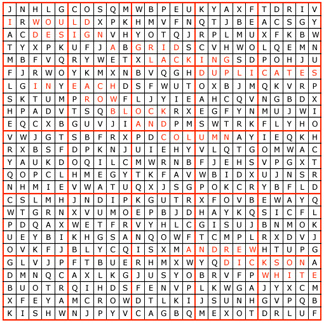Of puzzles, seductions and Andrew Dickson White
By Lauren Gold

Kathy Ramsey has a weakness for Sudoku puzzles. They beckon her with their tantalizing promises of a good challenge, of sweet triumph.
So when she glanced at the enticing 25-by-25 square in the March 2 issue of the Cornell Chronicle (which appeared with a story about Cornell physicist Veit Elser's work on X-ray diffraction microscopy), she flirted with a few of the easier clues. She figured she would toy with it in her spare time.
But, alas, it was no use. Her days became a feverish quest for the correct letters -- the ones that would at once satisfy the rigorous constraints of the game and spell (she guessed correctly) "Andrew Dickson White" somewhere within the giant box.
Now, it must be said that Ramsey was not the only one to take on the puzzle. Of the more than 4,000 people who downloaded it, eight (that we know of) solved it. The first was Glenn Fowler of the AT&T Research Group. It took him precisely 0.004 seconds, he reported crisply, using his handy 3.2 gigahertz Pentium.
But Fowler and the others are computer-savvy types who toss around terms like "constraint algorithms" and "integer programming" like yesterday's gossip. They plugged the puzzle into their pet algorithms -- used, perhaps, for genetic research or for performance optimization -- and voila! (By the way, computer science types -- if you read between the lines of the original Chronicle article and thought Elser had solved something called an NP-complete problem -- he hasn't. That mountain is still yours to climb.)
Ramsey was innocent of such means. "Until you mentioned it, I didn't even know you could solve the puzzle with a computer," she said. "I know zilch about algorithms. And isn't that losing the whole point of a puzzle?"
After it was all over, she told the story of the seduction.
"As the weeks went on, it was on the counter in the kitchen, and I was spending longer and longer on it during the day," confessed Ramsey, the mother of a 2005 Cornell graduate, from her Long Island home. "I said, you know, I'm not stopping here -- this is not going to beat me. I'm not stupid. I can solve this. By then, I wanted to get it done because it was just consuming my life."
She reduced her daughter's erasers to piles of dust. She began to obsess over strategies.
When Elser devised the giant Sudoku puzzle, he didn't really think anyone would be able to solve it. "I'm pleasantly surprised," he said.
Not to mention impressed. Multiply by 1 billion the time it would take an average computer (not Fowler's snazzy Pentium) to do the task (Elser estimates this is a fair ratio of computer-to-human solving time) -- and you get . . . well, a really long time.
"We're talking about a very determined person," Elser said of Ramsey.
"It was a lot of fun," said Ramsey. "It was frustrating, it was aggravating, it was time consuming. But that's what a puzzle is. It was fun at the end to put in that last letter and know I'm done."
So -- what now? Is she done with the ho-hum nine-by-nine puzzles in the newspaper? Or has the triumph quenched her Sudoku appetite once and for all?
Nope. And to Veit Elser, she has a challenge of her own.
"I hope he comes up with a bigger and better one."
Media Contact
Get Cornell news delivered right to your inbox.
Subscribe